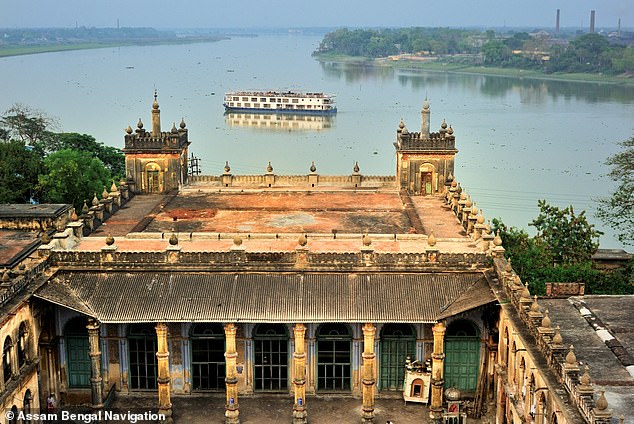My great-aunt Evelyn told me: ‘Did you know that your four-times great-uncle Charles was eaten by Johann Zoffany?’ As a boy, I never tired of hearing how my ancestor, returning from Calcutta (Kolkata) with the great artist, was shipwrecked in the Bay of Bengal. Being the youngest, and so most succulent, he was devoured by his fellow passengers.
But now certain that family history would not repeat itself, my wife and I took a rather gentler voyage up the Hooghly River, a tributary of the mighty Ganges, aboard ABN Rajmahal. The river boat was chartered by Ibex Expeditions and led by its founders, explorer Mandip Singh Soin and his indomitable wife, Anita.
Their company is named after the Himalayan mountain goat that goes ‘to places others cannot reach’. Hence, this was no ordinary river cruise, but a collection of surprises that gently unfolded over eight days.
The first (and last) night was spent at The Park hotel in Kolkata. We dined in splendour nearby at the Glenburn, where we met our companions, a mix of professionals from academia, business and the arts, even a top civil servant.
As we set off upstream, our good fortune became all too apparent. While not beautiful or sleek from the outside, Rajmahal was supremely comfortable.

Nicholas Courtney boards the ABN Rajmahal (pictured above) for a gentle voyage up the Hooghly River, a tributary of the Ganges

Nicholas starts his slow voyage in Kolkata and the boat travels beneath the city’s Howrah Bridge (above)
Slowly we left Kolkata, passing under the Howrah Bridge where it is said that the equivalent of the entire adult population of New Zealand crosses daily.
We went ashore at Barrackpore and walked to Flagstaff House – the original summer headquarters of the British in India, its grounds a fitting cemetery for the colonial statues removed from their lofty plinths in Kolkata.
Continuing the colonial theme, we visited Chandernagore, the former French colony marked with wide boulevards and Empire-style buildings, like wonderful Dupleix Palace, now a museum housing faded exhibits. I defy anyone not to be caught up in the history and culture of this area of West Bengal. At Hooghly village, an ordinary building hides a vast courtyard flanked by arched cloisters, a large pool and a clock tower.

Nicholas explores ‘a vast complex of fine Shiva temples’ which sit in ‘two concentric rings’ (pictured above) in Kalna
At Kalna, the intricacies of producing fine muslin were explained against the clacking of looms as the weavers produced their 2in (5cm) of cloth a day. Others spun raw cotton into thread.
An e-tuk tuk ride took us to another treat – a vast complex of fine Shiva temples. Before one of these stands the Mother of India tree -– five species growing as one. Across the road are the 108 terraced temples in two concentric rings, and then a huge temple that would dwarf St Peter’s in Rome unfolds like a vast Fabergé Easter egg.
We considered ourselves travellers, sailing along the Hooghly far from the usual tourist trail. Locals seemed genuinely pleased to see us.

‘The Kathgola Palace (pictured above), a neoclassical mansion built by a Jain banking family followed the visit to the Kathgola Mosque, with its sheer, simple beauty,’ says Nicholas
The river is narrow, so we could enjoy seeing life on both banks – a flock of whistling ducks or a solitary kingfisher, paddy fields worked by women in bright saris, villages. One such was Matiari, where barefooted workers poured molten brass into moulds, while others fed the ingots into rolling mills. Our ears were filled with the noise of hammering as pots and dishes were made by hand from sheet metal.
Ashore, e-tuk tuks took us to the site of the Battle of Plassey where, in 1757, Robert Clive defeated the forces of the Nawab of Bengal, Siraj-ud-Daulah, to establish British control over the region. It is marked by a fine obelisk and a bust of Siraj.
More culture lay further upstream within the Hazarduari Palace at Murshidabad, built by Colonel Duncan MacLeod in the 1830s, and resembling Buckingham Palace. The museum was intriguing but had confusing signage. I loved the painting of ‘Cleo Patra’.
The Kathgola Palace, a neoclassical mansion built by a Jain banking family followed the visit to the Kathgola Mosque, with its sheer, simple beauty. That night there was a barbecue on the top deck of the boat.
On our final day we visited Gaur, the 13th century former Bengali capital on the Bangladeshi border. Here we were spoiled by two more mosque complexes and the 15th century Firoz Minar octagonal tower.
Our river adventure ended at Farakka and a four-hour train journey back to Kolkata. We had enjoyed a voyage of the senses – the tintinnabulation of the metal workers; the bright colours of India (including Mandip’s turbans); the sheer muslin; the feasts on the Rajmahal and the sweet scents of the spice-laden air. We were truly blessed.

Nicholas visited Buckingham Palace lookalike Hazarduari Palace (pictured above) at Murshidabad, built by Colonel Duncan MacLeod in the 1830s

